Star Swarm, DirectX 12 AMD APU Performance Preview
by Ryan Smith & Ian Cutress on February 13, 2015 10:00 AM EST- Posted in
- GPUs
- AMD
- Microsoft
- APUs
- DirectX 12

After several requests and a week’s break from our initial DirectX 12 article, we’re back again with an investigation into Star Swarm DirectX 12 performance scaling on AMD APUs. As our initial article was run on various Intel CPU configurations, this time we’re going to take a look at how performance scales on AMD’s Kaveri APUs, including whether DX12 is much help for the iGPU, and if it can help equalize the single-threaded performance gap been Kaveri and Intel’s Core i3 family.
To keep things simple, this time we’re running everything on either the iGPU or a GeForce GTX 770. Last week we saw how quickly the GPU becomes the bottleneck under Star Swarm when using the DirectX 12 rendering path, and how difficult it is to shift that back to the CPU. And as a reminder, this is an early driver on an early OS running an early DirectX 12 application, so everything here is subject to change.
| CPU: | AMD A10-7800 AMD A8-7600 Intel i3-4330 |
| Motherboard: | GIGABYTE F2A88X-UP4 for AMD ASUS Maximus VII Impact for Intel |
| Power Supply: | Rosewill Silent Night 500W Platinum |
| Hard Disk: | OCZ Vertex 3 256GB OS SSD |
| Memory: | G.Skill 2x4GB DDR3-2133 9-11-10 for AMD G.Skill 2x4GB DDR3-1866 9-10-9 at 1600 for Intel |
| Video Cards: | MSI GTX 770 Lightning AMD APU iGPU |
| Video Drivers: | NVIDIA Release 349.56 Beta AMD Catalyst 15.200 Beta |
| OS: | Windows 10 Technical Preview 2 (Build 9926) |
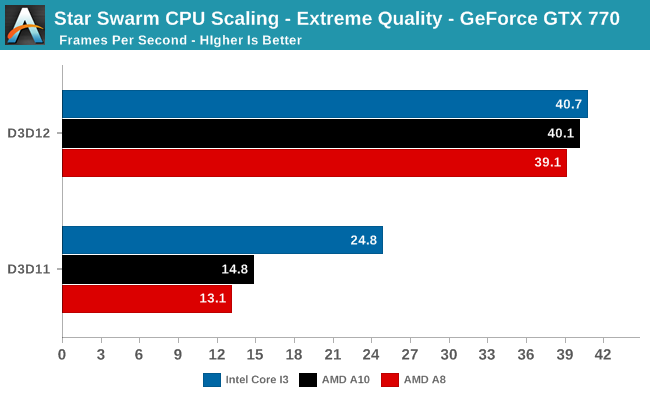
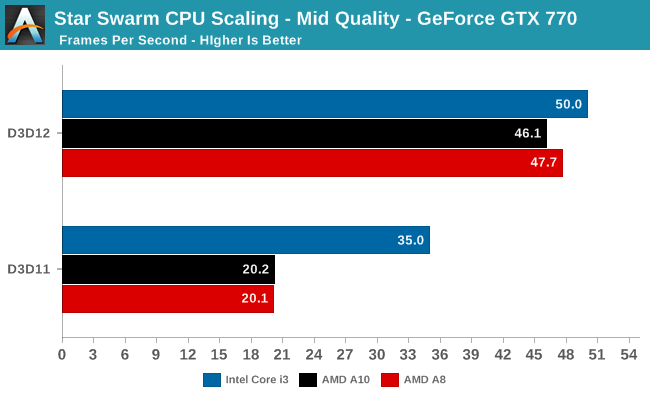
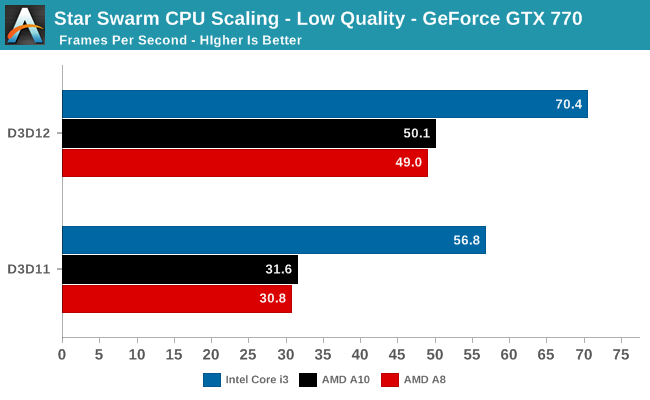
To get right down to business then, are AMD’s APUs able to shift the performance bottleneck on to the GPU under DirectX 12? The short answer is yes. Highlighting just how bad the single-threaded performance disparity between Intel and AMD can be under DirectX 11, what is a clear 50%+ lead for the Core i3 with Extreme and Mid qualities becomes a dead heat as all 3 CPUs are able to keep the GPU fully fed. DirectX 12 provides just the kick that the AMD APU setups need to overcome DirectX 11’s CPU submission bottleneck and push it on to the GPU. Consequently at Extreme quality we see a 64% performance increase for the Core i3, but a 170%+ performance increase for the AMD APUs.
The one exception to this is Low quality mode, where the Core i3 retains its lead. Though initially unexpected, examining the batch count differences between Low and Mid qualities gives us a solid explanation as to what’s going on: low pushes relatively few batches. With Extreme quality pushing average batch counts of 90K and Mid pushing 55K, average batch counts under Low are only 20K. With this relatively low batch count the benefits of DirectX 12 are still present but diminished, leading to the CPU no longer choking on batch submission and the bottleneck shifting elsewhere (likely the simulation itself).
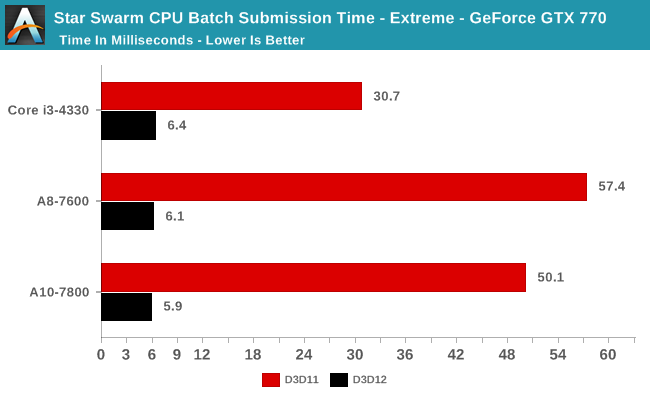
Meanwhile batch submission times are consistent between all 3 CPUs, with everyone dropping down from 30ms+ to around 6ms. The fact that AMD no longer lags Intel in batch submission times at this point is very important for AMD, as it means they’re not struggling with individual thread performance nearly as much under DirectX 12 as they were DirectX 11.
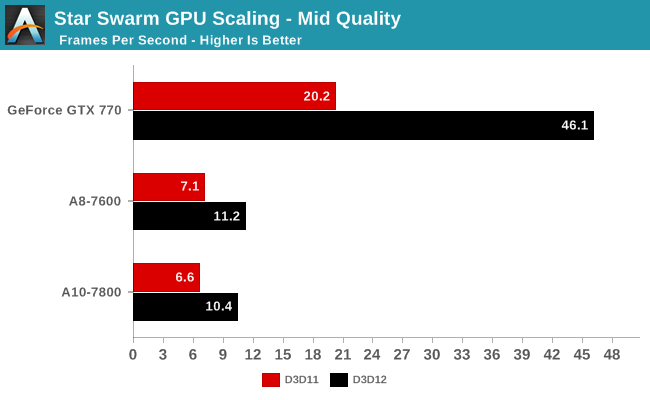

Finally, taking a look at how performance scales with our GPUs, the results are unsurprising but none the less positive for AMD. Aside from the GTX 770 – which has the most GPU headroom to spare in the first place – both AMD APUs still see significant performance gains from DirectX 12 despite running into a very quick GPU bottleneck. This simple API switch is still enough to get another 44% out of the A10-7800 and 25% out of the A8-7600. So although DirectX 12 is not going to bring the same kind of massive performance improvements to iGPUs that we’ve seen with dGPUs, in extreme cases such as this it still can be highly beneficial. And this still comes without some of the potential fringe benefits of the API, such as shifting the TDP balance from CPU to GPU in TDP-constrained mobile devices.
Looking at the overall picture, just as with our initial article it’s important not to read too much into these results right now. Star Swarm is first and foremost a best case scenario and demonstration for the batch submission benefits of DirectX 12. And though games will still benefit from DirectX 12, they are unlikely to benefit quite as greatly as they do here, thanks in part to the much greater share of non-rendering tasks a CPU would be burdened with in a real game (simulation, AI, audio, etc.).
But with that in mind, our results from bottlenecking AMD’s APUs point to a clear conclusion. Thanks to DirectX 12’s greatly improved threading capabilities, the new API can greatly close the gap between Intel and AMD CPUs. At least so long as you’re bottlenecking at batch submission.










152 Comments
View All Comments
amilayajr - Saturday, February 14, 2015 - link
Can you please set up a test without i3 using a dedicated GPU. Intel integrated graphics vs AMD APU, that's what we need to see. It's biased to partner an i3 with a dedicated GPU vs AMD APU. Dedicated GPU will kick the crap out of AMD APUs. From this test, it totally shows how great AMD APUs are considering they didn't even need to use a dedicated GPU and still manage to keep up closed to an i3 with dedicated gpu.Ryan Smith - Saturday, February 14, 2015 - link
Unfortunately we do not currently have WDDM 2.0 drivers for Intel, so we can only test NVIDIA and AMD GPUs.beffin - Saturday, February 14, 2015 - link
It took them this long to reverse engineer Mantle? I'm quite disappointed in you.D. Lister - Saturday, February 14, 2015 - link
Development of DX12 is older than Mantle, and also, AMD has been a development partner for DX12 from the start. Remember, search engines (like Google or Bing), are very useful for looking up this sort of stuff.FlushedBubblyJock - Sunday, February 15, 2015 - link
So AMD stole DX12 ideas and flaked out their Mantle, good to know.FlushedBubblyJock - Sunday, February 15, 2015 - link
PS - I'm so glad our greatest reviewer here continues to give AMD credit for forcing Intel with Mantle to do a DX12...Yes, what wondrous minds do appear with a mini-AMD mantle reindeer.
D. Lister - Sunday, February 15, 2015 - link
https://scalibq.wordpress.com/2014/03/27/who-was-f..."AMD was a part of all DX12 development, and was intimately familiar with the API details and requirements"
http://www.extremetech.com/gaming/177407-microsoft...
"In fact, as some of you may recall, an AMD executive publicly stated a year ago that there was no “DirectX 12″ on the Microsoft roadmap."
http://techreport.com/review/26239/a-closer-look-a...
"I think it's entirely possible AMD has known about D3D12 from the beginning, that it pushed ahead with Mantle anyhow in order to secure a temporary advantage over the competition"
:) That right there is the AMD marketing milkshake that brings all the fanboys to their yard, to put it crudely.
zodiacfml - Saturday, February 14, 2015 - link
Good for AMD but it still doesn't solve its problems in application performance or raw cpu performance where the Intel equivalent is faster and lower power at the same time.It could be useful though for improving the AMD based gaming consoles.
FlushedBubblyJock - Sunday, February 15, 2015 - link
What just happened is Intel and nVidia "got mantle". Now AMD's high end is further threatened, whilst they have a huge driver rewrite burden, dangerous for them and not dangerous for nVidia or Intel with all their spare $, so what just happened is AMD just got another kill the zombie chop to their forehead - with the +12 giant two handed ax.amilayajr - Saturday, February 14, 2015 - link
This review/benchmark is not good. Why does i3 uses a dedicated GPU while it's being ram against AMD APU. Can't you do a test that intel hd graphics go head to head with AMD APU? By the looks of it, AMD APU is a winner here to be able to produce that much performance while being integrated graphics. Any chance you can do just intel vs amd apu graphics....?